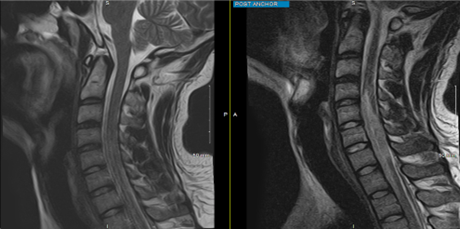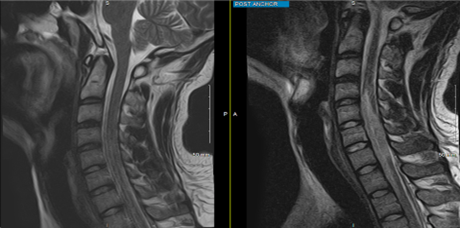Case Report
Spinal Infarction in a Young Adult without Predisposing Risk Factors: A Case Report
- Iqbal Grewal
- Omar Elsemary *
- Saifullah Nasim
- Nadeem Mukhtar
College of Medicine, California North state University College of Medicine, Elk Grove, USA.
*Corresponding Author: Omar Elsemary, College of Medicine, California North state University College of Medicine, Elk Grove, USA.
Citation: Grewal I, Elsemary O, Nasim S, Mukhtar N. (2023). Spinal Infarction in a Young Adult without Predisposing Risk Factors: A Case Report. Clinical Case Reports and Studies, BRS Publishers. 2(4); DOI: 10.59657/2837-2565.brs.23.041
Copyright: © 2023 Omar Elsemary, this is an open-access article distributed under the terms of the Creative Commons Attribution License, which permits unrestricted use, distribution, and reproduction in any medium, provided the original author and source are credited.
Received: May 19, 2023 | Accepted: June 02, 2023 | Published: June 09, 2023
Abstract
Spinal cord infarctions are a form of stroke characterized by ischemia originating within the spinal cord or its supplying arteries. Presentation of spinal cord infarctions vary greatly due to its diverse pathologies, but can include bladder dysfunction, paraplegia, quadriplegia, etc. The average age of people with this disease tends to be older adults, with very few reported cases in the younger demographic. Here, we report a case of spinal infarction in a young 25-year-old adult male with no predisposing risk factors.
Keywords: spinal infarction; young adult; predisposing; stroke; diverse pathologies
Introduction
Spinal infarctions are a result of spinal artery blockage leading to ischemic damage of spinal tissue. They account for 1% of all strokes with a reported 12,000 new cases annually in the United States [1,2,3]. Patients with spinal infarctions commonly present with a variety of severe deficits including paraplegia, quadriplegia, back pain, weakness, loss of sensation, and other neurological symptoms depending on the level of spinal cord affected. Treatment of spinal infarctions remains elusive due to the lack of standard guidelines [4]. Commonly, treatment consists of supportive care oriented around addressing the associated symptoms and improving quality of life.
The spinal cord is supplied by an anterior spinal artery and two posterior spinal arteries, disruption of this supply can lead to disrupted oxygen and glucose delivery that deteriorates the spinal tissue [5] These etiologies can either be due to trauma (ie falls, motor vehicle collisions, blunt or penetrating injuries) or occur spontaneously. While spinal infarction due to trauma accounts for about 90% of cases [6]. the number of spontaneous/idiopathic cases has gradually increased over time. Risk factors include hypertension, diabetes mellitus, hyperlipidemia, and other vascular effects [7].
Spinal infarctions typically occur in older adults, as expected given their increased risk of vascular disease. Notably, various studies have found the mean age of spinal infarctions patients to be in the mid-60s [8,9] Evident from current literature, spinal infarctions in young adults are quite rare. In this case study, we report a case of spinal infarction in a 25-year-old patient who presents without any predisposing risk factors.
Case Report
We present a 25-year-old man with a history of multiple left shoulder dislocations and polysubstance use, who presented to the ED for acute motor weakness and loss of sensation of bilateral upper and lower extremities. Earlier that night, the patient attended a house party with reported alcohol and marijuana use. He attempted to perform a “windmill”, a breakdance move that involved him balancing on his head momentarily. Afterwards, he began to experience sudden weakness and numbness in his hands with difficulty gripping. He did not notice any significant pain in his neck or back at the onset of his injury. He did not go to the ED immediately, thinking that his symptoms would resolve on its own. Gradually, his decreased sensation and motor strength progressed into both his legs, causing him to have an unstable gait. The patient decided to call 911 and was brought to the ED by ambulance. In the ED, the patient reported not having a formal evaluation for at least 5 hours with his symptoms rapidly progressing to complete paralysis of his lower extremities. On physical exam, the patient had 3/5 motor strength of bilateral shoulders and elbows, 0/5 wrist and finger strength with complete loss of fine motor ability, and 0/5 strength of lower extremities. Loss of all sensation at about T2-T3 spinal level and below. Patient had no chronic medical conditions, no prior surgeries, no medications, and no significant family history. An initial MRI of his spine was suggestive of inflammation vs demyelination as read by the on-call radiologist, concerning for transverse myelitis. Patient was started on high-dose steroids with plasma exchange. He did not clinically improve. A repeat MRI 4 days later was more consistent with spinal infarction. Work-up of his infarction was essentially negative with normal coagulation studies, normal transesophageal echocardiogram, and no evidence of a deep vein thrombosis. Hospital course was complicated by deteriorating respiratory status requiring mechanical ventilation, chronic pressure ulcers, and urinary tract infections. Patient underwent a tracheostomy for long-term ventilatory support and eventually transferred to a high-level spinal cord rehabilitation skilled nursing facility.
Conclusion
Spinal cord injuries (SCI) can have traumatic and nontraumatic causes. Traumatic SCIs occur due to the mechanical forces applied to the spinal cord which can cause tearing of the spinal cord and damage to the blood supply of the spinal cord [10] Nontraumatic causes of SCIs may include infection, arterial compression by tumors, birth defects, blood clots, and hemorrhages [11] Commonly, blockage of the anterior spinal artery and two posterior spinal arteries presents with a variety of symptoms due to ischemia of the tissue. Here, the patient presents with loss of sensation at and below the T4 level along with complete paralysis of the lower extremities, suggesting that all three spinal arteries were involved in the infarction leading to ischemic damage to the spinal cord.
Figure 1: MRI of cervical spine, sagittal view, day 1 of hospital admission. Slight hyperintensity from C4 to to T1. Initial radiology impression was inflammatory vs demyelinating process.
Figure 2: MRI of cervical spine, sagittal view, day 4 of hospital admission. Abnormal T2 signal from C4 to at least T1. Impression this time suggests spinal infarction.
The primary diagnostic method used in the case of spinal cord injuries is magnetic resonance imaging (MRI). MRIs allow for detection of ischemic damage in the spinal tissue. The patient's MRIs are included in Figures 1-2 and display the ischemia caused to the spinal cord starting at the C4 level. The initial MRI taken on the first day of hospitalization lacks any evidence of tearing of the spinal cord proving that the trauma primarily caused damage to the spinal arteries leading to permanent ischemic damage to the spinal tissue. Definitive treatment for spinal infarctions remains ambiguous due to its rare, diverse etiology. Rather, treatment is aimed towards addressing the underlying cause of the injury or its associated risk factors. For example, spinal infarction due to aortic aneurysms can be addressed with CSF drainage via a lumbar catheter while infractions due to vertebral artery dissection can be improved with antithrombotics [4] In this case report, the patient was given high dose steroids with plans of plasma exchange in efforts to address potential inflammatory myelitis, a common differential of spinal infarctions [12] due to its protective effects on cell function and reducing oxidative stress after ischemic injury [13] In addition to risk factor-focused treatment, rehabilitation is key in long-term treatment. To address the associated symptoms, patients are provided supportive care options to improve quality of life. For instance, bladder dysfunction is a common complication in spinal infarction patients, thus many of them are provided catheters. Here, the patient was eventually discharged to a hospital that specializes in long-term acute care for patients who suffer from critical and chronic illnesses.
Chronic conditions, including strokes, make up about seventy five percent of all healthcare spending and account for more than two thirds of all deaths in the United States [14] These conditions have also been shown to negatively affect the mental health of those affected. Many of those with chronic illnesses who were asked about their recent mental health reported that they have felt “mentally unhealthy” due to their conditions [14] Patients with these conditions are also at a much higher risk for developing other conditions that would negatively affect their health and preventative measures must be taken. Unfortunately, however, many of these patients are unable to do so due to physical limitations, such as in this case. Taking these factors into consideration, the patient’s young age makes considering a lifestyle-integrated approach especially important in his treatment plan, thus, his discharge to a long-term acute care facility. In addition to the physical limitation’s patients may have, there are many people in the United States who do not have the adequate health insurance to treat these diseases, which may further exacerbate their condition. This has been shown to have negative health outcomes and often leads to more hospitalizations in patients with chronic conditions and this is something that must be taken into consideration when treating these patients [14].
Conclusion
In conclusion, this report described a case with an unusual presentation of spinal infarction and provided information regarding the patient’s condition. Although spinal infarction is relatively rare in young adults, this case shows that it is important to consider. We compiled information regarding the pathophysiology, current testing, and treatment of spinal infarction which will prove useful in cases with similar presentation. Further studies on the course of disease in these patients is required to better understand the prognoses and evolution of such conditions.
References
- NINDS. (2021). Spinal cord infarction information page. (n.d.).
Publisher | Google Scholor - Sandson, T. A., & Friedman, J. H. (1989). Spinal cord infarction. Report of 8 cases and review of the literature. Medicine, 68(5):282-292.
Publisher | Google Scholor - NINDS. (2021). Spinal cord injury: Hope through research. (n.d.).
Publisher | Google Scholor - Nasr, D. M., & Rabinstein, A. (2017). Spinal cord infarcts: risk factors, management, and prognosis. Current treatment options in neurology, 19(8):1-10.
Publisher | Google Scholor - Ge, L., Arul, K., Stoner, M., & Mesfin, A. (2020). Etiology and Outcomes of Spinal Cord Infarct: A Case Series From a Level 1 Trauma Center. Global Spine Journal, 10(6):735-740.
Publisher | Google Scholor - WHO. (2021). Spinal cord injury. (n.d.).
Publisher | Google Scholor - Millichap, J. J., Sy, B. T., & Leacock, R. O. (2007). Spinal cord infarction with multiple etiologic factors. Journal of general internal medicine, 22(1):151-154.
Publisher | Google Scholor - Robertson, C. E., Brown, R. D., Wijdicks, E. F., & Rabinstein, A. A. (2012). Recovery after spinal cord infarcts: long-term outcome in 115 patients. Neurology, 78(2):114-121.
Publisher | Google Scholor - Qureshi, A. I., Afzal, M. R., & Suri, M. F. K. (2017). A population-based study of the incidence of acute spinal cord infarction. Journal of vascular and interventional neurology, 9(4):44.
Publisher | Google Scholor - Alizadeh, A., Dyck, S. M., & Karimi-Abdolrezaee, S. (2019). Traumatic spinal cord injury: an overview of pathophysiology, models and acute injury mechanisms. Frontiers in neurology, 10:282.
Publisher | Google Scholor - (2021). Non-trauma spinal cord injury. (n.d.).
Publisher | Google Scholor - Park, D., Kim, B. H., Lee, S. E., Park, J. K., Cho, J. M. (2020). Spinal Cord Infarction: A Single Center Experience and the Usefulness of Evoked Potential as an Early Diagnostic Tool. Frontiers in neurology, 11.
Publisher | Google Scholor - Patel, S., Naidoo, K., & Thomas, P. (2014). Spinal cord infarction: a rare cause of paraplegia. Case Reports, bcr2013202793.
Publisher | Google Scholor - Raghupathi, W., & Raghupathi, V. (2018). An empirical study of chronic diseases in the United States: a visual analytics approach to public health. International journal of environmental research and public health, 15(3):431.
Publisher | Google Scholor















